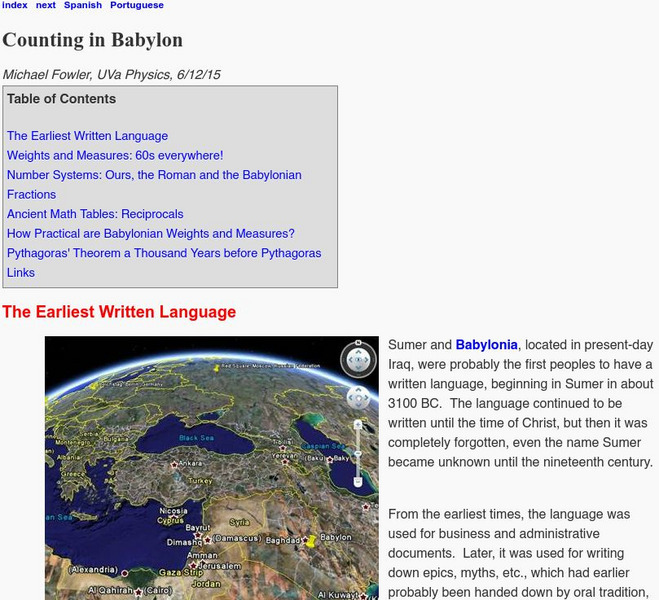Curated OER
Babylonian Number System
In this Babylonian number system instructional activity, students read an explanation of the number symbols used by Babylonians and respond to 3 questions regarding the information presented.
Partnership for Educating Colorado Students
Mayan Mathematics and Architecture
Take young scholars on a trip through history with this unit on the mathematics and architecture of the Mayan civilization. Starting with a introduction to their base twenty number system and the symbols they used, this eight-lesson unit...
EngageNY
Systems of Equations Leading to Pythagorean Triples
Find Pythagorean Triples like the ancient Babylonians. The resource presents the concept of Pythagorean Triples. It provides the system of equations the Babylonians used to calculate Pythagorean Triples more than 4,000 years ago. Pupils...
Time Warp Trio
The Seven Blunders of the World
Learners explore the cultures and civilizations of Mesopotamia. They take a look at the factors that shaped the region, and study the history of the Hanging Gardens of Babylon, and other ancient wonders of the world. The class is divided...
Curated OER
Detective Digis and the Computer Caper
Mathematicians participate in an hands-on activity to investigate the binary number system and write messages in binary code and have classmates decipher the messages. A said video on the topic does not seem to be available, but the...
Big Kid Science
Eclipse Classroom Activities: Cultural Significance Project
What better way to celebrate eclipses than across cultures? Explore myths of solar and lunar eclipses from ancient cultures like the Chinese, Ancient Greek, Mesoamerican, Incan, Egyptian, Ancient Babylonian, and Middle Eastern. Learners...
Curated OER
It's A Snap! (Place Value Made Easy)
Students are introduced to the importance of using place value in number systems. They view a video, play games, explore websites and research the pay scale of three jobs that interest them.
Penn Museum
Ancient History Math Mystery
Through several organized and attractive worksheets, your learners will make a deduction about tally marks and hieroglyphics to determine what they represent in the ancient numeral system. This is a well-designed, interdisciplinary...
Space Awareness
Making A Sundial
Can people really measure time just by using the sun? Scholars venture outside on a nice, sunny day to build sundials and learn how people measured time 600 years ago. The class builds two different sundials while gaining practice with...
Curated OER
Applied Science - Science and Math Lab
Although it was written to use in a science class, this measurement lesson is adaptable to Common Core standards in math for measurement and data. Youngsters are introduced to two types of measurement systems. They use both the...
Foreign Policy Research Institute
A Geography Lesson
Fewer and fewer people have a strong grasp of world geography, but this activity helps students understand geopolitics by creating their own original historical map. The activity requires selecting a country from the list provided,...
Curated OER
Tomb Robbers
Sixth graders identify benchmark angles as they are embedded into a circle grid. They observe the teacher using an angle ruler and complete a Star Spangled worksheet, play the game Tomb Robbers, and as a class discuss their game winning...
Curated OER
Cultural Calendar
Young scholars design their own cultural calendar. In this calendar making lesson, students decide on a culture for a calendar theme and discuss how calendars differ from the US calendar. Young scholars create their own...
Curated OER
Angle Land and Angle Aerobics
Sixth graders investigate different types of angles. In this geometry instructional activity, 6th graders use a protractor to identify acute, obtuse, and straight angles.
National Council of Teachers of Mathematics
The Math Forum: Ask Dr. Math: Babylonian Number System
Dr. Math takes on a question about the Babylonian base-60 math system, explaining how a sexagesimal system looks and works in comparison with our decimal (base 10) system.
University of St. Andrews (UK)
University of St. Andrews: An Overview of Babylonian Mathematics
Information and examples of how the base 60 number system of the Babylonians worked in calculating problems similar to those we face today. Has a section comparing Pythagoras's theorem to Babylonian math.
PBS
Pbs: Base 60: Babylonian Decimals
Explore a brief history of mathematics in Mesopotamia through the Babylonian Base 60 number system. This video focuses on how a base 60 system does not use fractions or repeating decimals, some of the advantages of a base 60 system, and...
University of Virginia
University of Virginia: Counting in Babylon
A discussion of the number system used by the ancient Babylonians. Examples are provided for various mathematical operations based on the number 60 (our number system is based on the number ten).
New York University
Institute for the Study of the Ancient World: Before Pythagoras
Exhibition of cuneiform tablets dating from 1900 B.C. demonstrates the mathematical knowledge of the ancient Mesopotamians.
National Council of Teachers of Mathematics
The Math Forum: Famous Problems in the History of Mathematics
On this site, there are several math problems to explore and solve. Look through some solutions by famous mathematicians and expand your thinking about some interesting math concepts. Teachers of elementary grades may want to use this...


















